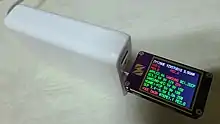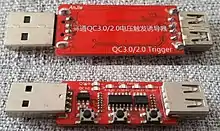Quick Charge
Quick Charge (QC) is a proprietary battery charging protocol developed by Qualcomm, used for managing power delivered over USB, mainly by communicating to the power supply and negotiating a voltage.

Quick Charge is supported by devices such as mobile phones which run on Qualcomm SoCs, and by some chargers; both device and charger must support QC, otherwise QC charging is not attained. It charges batteries in devices faster than standard USB allows by increasing the output voltage supplied by the USB charger, while adopting techniques to prevent the battery damage caused by uncontrolled fast charging and regulating the incoming voltage internally. Many chargers supporting Quick Charge 2.0 and later are wall adaptors, but it is implemented on some in-car chargers, and some power banks use it to both receive and deliver charge.
Quick Charge is also used by other manufacturers' proprietary rapid-charging systems.
Details
Quick Charge is a proprietary technology that can charge battery-powered devices, primarily mobile phones, at power levels exceeding the ten watts (5 volts at 2 amps) supported by the basic USB standard, using existing USB cables. The higher voltage available allows more power (watts) to be supplied through wires without excessive heating. As current is lower for the same power if voltage is increased, there is less resistive loss, which becomes significant for longer cables.
Numerous other companies have competing technologies, including MediaTek Pump Express and OPPO VOOC (licensed to OnePlus as Dash Charge), the latter of which supplies higher current without voltage increase, relying on thicker USB wires to handle the current without overheating, as described in VOOC § Technology.[1]

Though not publicly documented, the voltage negotiation between device and charger has been reverse-engineered, and a custom voltage can be manually requested from the charger using a trigger circuit that simulates the negotiation to an end device.[2][3]
Quick Charge requires both the power supply and the device being charged to support it, otherwise charging falls back to the standard USB ten watts.
Quick Charge 2.0 introduced an optional feature called Dual Charge (initially called Parallel Charging),[4] using two PMICs to split the power into 2 streams to reduce phone temperature.[5]
Quick Charge 3.0 introduced INOV (Intelligent Negotiation for Optimal Voltage), Battery Saver Technologies, HVDCP+, and optional Dual Charge+. INOV is an algorithm that determines the optimum power transfer while maximizing efficiency. Battery Saver Technologies aims to maintain at least 80% of the battery's original charge capacity after 500 charge cycles.[6] Qualcomm claims Quick Charge 3.0 is up to 4–6 °C cooler, 16% faster and 38% more efficient than Quick Charge 2.0, and that Quick Charge 3.0 with Dual Charge+ is up to 7–8 °C cooler, 27% faster and 45% more efficient than Quick Charge 2.0 with Dual Charge.[4]
Quick Charge 4 was announced in December 2016 for the Snapdragon 835 and later chips. Quick Charge 4 supports HVDCP++, optional Dual Charge++, INOV 3.0, and Battery Saver Technologies 2. It is cross-compatible with both USB-C and USB-PD specifications, supporting fallback to USB-PD if either the charger or device is not QC-compatible. However, Quick Charge 4 chargers are not backward compatible with Quick Charge. It also features additional safety measures to protect against over-voltage, over-current and overheating, as well as cable quality detection. Qualcomm claims Quick Charge 4 with Dual Charge++ is up to 5 °C cooler, 20% faster and 30% more efficient than Quick Charge 3.0 with Dual Charge+.[5]
Quick Charge 4+ was announced on June 1, 2017. It introduces Intelligent Thermal Balancing and Advanced Safety Features to eliminate hot spots and protect against overheating and short-circuit or damage to the USB-C connector. Dual Charge++ is mandatory, while in prior versions Dual Charge was optional. Unlike Quick Charge 4, Quick Charge 4+ is fully backward compatible with Quick Charge C 2.0 and 3.0 devices.[7][8]
Quick Charge 5 was announced on July 27, 2020.[9] With up to 100 W of power, on a mobile phone with a 4500 mAh battery, Qualcomm claims 50% charge in just 5 minutes. Qualcomm announced that this standard is cross-compatible with USB PD PPS programmable power supply, and that its technology can communicate with the charger when charging double cells and double the voltage and current out. For instance, a single battery requests 8.8 V; the dual cell can then ask the PPS charger to output 17.6 volts and split it in half to the two separate batteries, providing 5.6 amps total to achieve 100 watts. The first phone supporting this technology was the Xiaomi Mi 10 Ultra.[10]
Quick Charge for Wireless Power
On February 25, 2019, Qualcomm announced Quick Charge for Wireless Power. Quick Charge for Wireless Power falls back on the Qi standard by the Wireless Power Consortium if either the charger or device is not compatible.[11]
Versions
| Technology | Release date | Voltage | Maximum | New features | SoCs | |
|---|---|---|---|---|---|---|
| Current | Power[lower-alpha 1] | |||||
| Quick Charge 1.0 | 2013 | Up to 6.3 V[12] | 2 A | 10 W |
|
Snapdragon 215, 600[13][14] |
| Quick Charge 2.0 | 2014[lower-alpha 2] |
|
1.67 A, 2 A, or 3 A | 18 W (9 V × 2 A)[17][lower-alpha 3] |
|
Snapdragon 200, 208, 210, 212, 400, 410, 412, 415, 425, 610, 615, 616, 653, 800, 801, 805, 808, 810[18] |
| Quick Charge 3.0 | 2016 | 3.2 or 3.6 V – 20 V in 0.2 V increments. (inconsistent sources)[19][16][20] | 2.6 A, or 4.6 A[19] | 36 W (12 V × 3 A) |
|
Snapdragon 427, 429, 430, 435, 439, 450, 460, 617, 620, 625, 626, 632, 650, 652, 653, 662, 665, 680, 820, 821[18] |
| Quick Charge 3+ | 2020 | scalable voltage with 20mV steps from Quick Charge 4 | ? | ? |
|
Snapdragon 765, 765G[21] |
| Quick Charge 4 | 2017 |
|
|
|
|
Snapdragon 630, 636, 660, 710,[23][24] 720G, 835,[25][26] 845[27] |
| Quick Charge 4+ |
|
Snapdragon 480, 480+, 4 Gen 1, 670, 675, 678, 690, 695, 6 Gen 1, 712, 730, 730G, 732G, 750G, 765, 765G, 768G, 778G, 780G, 7 Gen 1,[28] 855, 855+/860, 865, 865+, 870[29][30] | ||||
| Quick Charge 5 | 2020 | ? | ? | >100 W |
|
Snapdragon 888, 888+, 8 Gen 1, 8+ Gen 1,[31] 7+ Gen 2[32] |
Other charging protocols
Compatible with QC-enabled chargers
USB Power Delivery
Other proprietary protocols
- DART (Realme, 2020 onwards) – interchangeable with SuperVOOC
- Pump Express (MediaTek)
- Super Flash Charge (Vivo, 2020 onwards)
- SuperCharge (Huawei)
- SuperVOOC (OPPO, from 2019 to present)
- VOOC (OPPO, until 2019 and pre-2020 Realme models)
- Warp Charge, formerly Dash Charge (OnePlus) – interchangeable with SuperVOOC
- XCharge (Infinix)
Notes
- Some mobile phones deactivate fast charging during operation, and only activate fast charging during standby mode or power-off state.
- The Galaxy Note 4, released in September 2014, was already equipped with Quick Charge 2.0.[15]
- Because Quick Charge 3.0 power supplies are backwards-compatible with Quick Charge 2.0, Quick Charge 3.0 chargers are often able to deliver more power to Quick Charge 2.0 loads than Quick Charge 2.0 chargers, since Quick Charge 3.0 chargers support higher currents at the same voltages.
- Samsung's own 15 W Quick Charge 2.0 mobile phone chargers only support 5 and 9 volts (at 2 A and 1.67 A respectively), not 12 volts (at which 1.25 A is supported by some other 15 W Quick Charge 2.0 chargers).[33][34]
References
- "How fast can a fast-charging phone charge if a fast-charging phone can charge really fast?". CNet. 2 December 2016. Retrieved 4 December 2016.
- "Custom voltage from Qualcomm Quick Charge powerbank". Hackster.io. 20 March 2018.
- "Unlocking 12V Quick Charge On A USB Power Bank". Hackaday. 4 March 2017.
- Roach, Everett (September 2015). "Advancing charging technologies: Qualcomm Quick Charge" (PDF). Qualcomm.
- Humrick, Matt. "Qualcomm Announces Quick Charge 4: Supports USB Type-C Power Delivery". www.anandtech.com. Retrieved 20 August 2019.
- "Introducing Quick Charge 3.0: next-generation fast charging technology". Qualcomm. 14 September 2015. Retrieved 20 August 2019.
- "For fast charging, look for Qualcomm Quick Charge 4+ in your next mobile device". Qualcomm. 1 June 2017. Retrieved 20 August 2019.
- "How can Quick Charge 4+ turbocharge your mobile device?". Qualcomm. 23 February 2018. Retrieved 20 August 2019.
- "Qualcomm Announces World's Fastest Commercial Charging Solution, Quick Charge 5, World's First Commercial 100W+ Charging Platform". 27 July 2020.
- Russell, Brandon (12 August 2020). "The Xiaomi Mi 10 Ultra is the first phone with Qualcomm's 100W+ Quick Charge 5 technology". www.xda‑developers.com. Retrieved 24 February 2021.
- "Qualcomm Announces Quick Charge for Wireless Power and Introduces Qi Interoperability". Qualcomm. 24 February 2019. Retrieved 20 August 2019.
- Qualcomm.com: Qualcomm Quick Charge 1.0 Battery Charger ICs
- "Qualcomm Quick Charge 1.0: Less Time Charging, More Time Doing". Qualcomm. 14 February 2013. Retrieved 5 December 2016.
- "Qualcomm's Quick Charge 2.0 technology explained". Android Authority. 6 November 2014. Retrieved 5 December 2016.
- "Galaxy Note 4: To use fast charging, what kind of charger should be used?". Samsung.com.
- "What is Qualcomm Quick Charge?". Power Bank Expert. 18 January 2020. Retrieved 21 July 2020.
- "What is Qualcomm Quick Charge 3.0?". Belkin. Retrieved 20 August 2019.
- "Compare Snapdragon Processors". Qualcomm. Retrieved 14 May 2017.
- "Quick Charge 3.0 specs". Qualcomm.
- "Qualcomm Quick Charge 3.0: the Good, the Bad, and the Ugly". pocketnow.com. 22 September 2015.
voltage between 3.2V and 20V at 200mV increments
- "Introducing Qualcomm Quick Charge 3+, fast and efficient charging for the masses". Retrieved 2 March 2022.
- "Fresco Logic to demonstrate the Industry's First USB-C PD3.0 Programmable Power Supply (PPS) Total Solution". Archived from the original on 28 February 2018. Retrieved 25 February 2018.
- "Snapdragon 710 Mobile Platform Qualcomm". Qualcomm. Retrieved 25 August 2018.
- "Qualcomm® Snapdragon™ 710 Mobile Platform" (PDF).
- "Qualcomm can charge your phone faster than you can read this story". CNET. Retrieved 4 December 2016.
- "Snapdragon 835 Mobile Platform". Qualcomm. Retrieved 25 August 2018.
- "Snapdragon 845 Mobile Platform | Qualcomm". www.qualcomm.com. Retrieved 2 June 2022.
- "Snapdragon 7 Gen 1 Mobile Platform | Qualcomm". www.qualcomm.com. Retrieved 2 June 2022.
- "Snapdragon 845 Mobile Platform | Qualcomm". Qualcomm. Retrieved 4 January 2018.
- "Qualcomm® Snapdragon™ 845 Mobile Platform" (PDF).
- "Snapdragon 8+ Gen 1 Mobile Platform | Latest premium-tier powerhouse | Qualcomm". www.qualcomm.com. Retrieved 2 June 2022.
- "Snapdragon 7+ Gen 2 Mobile Platform | Qualcomm". www.qualcomm.com. Retrieved 5 July 2023.
- "Samsung EP-TA20EWEU". Samsung de (in German). Retrieved 8 November 2020.
- "Voltcraft CQCP2400 operating instructions" (PDF) (User manual). Voltcraft.
Output voltage/current 5 V/DC, max. 2400 mA or 9 V/DC, max. 1670 mA or 12 V/DC, max. 1250 mA